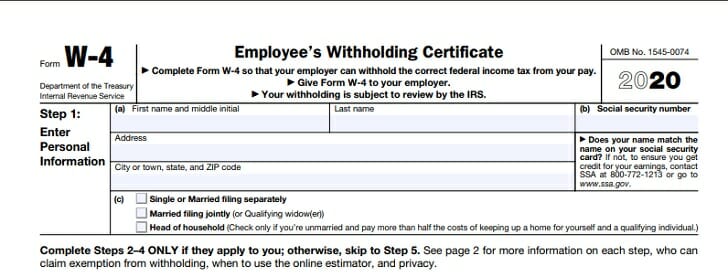How to Fill Out Your W-4 Form? Answers to FAQ About the W-4
If you’re filling out a Form W-4, you probably just started a new job. Or maybe you recently got married or had a baby. The W-4, also called the Employee’s Withholding Certificate, tells your employer how much federal income tax to withhold from your paycheck. The form was redesigned for 2020, which is why it looks different if you’ve filled one out before. The biggest change is that it no longer talks about “allowances,” which many, if not most, people found baffling. Instead, if you want an additional amount withheld (perhaps your spouse earns considerably more than you), you simply state the amount per pay period. Because you may not have the numbers on you, some HR departments are letting new employees take the form home to fill out (they used to require you to fill it out the first day on the job.) Here, we answer frequently asked questions about the W-4, including how to fill it out, what’s changed and how the W-4 is different from the W-2.
Why Do I Need to Fill Out Form W-4?
As just noted, the form tells your employer how much federal income tax to withhold from your paycheck. You’ll need to complete a new W-4 every time you start a new job. If your new company forgets to give you one for some reason, be sure to ask. If your employer doesn’t have a W-4 form from you, the IRS requires it to treat you as a single tax filer, which means withholding the highest possible amount for taxes. You can get back the amount you overpay, but only in the new year when you file your tax return.
Do I Need to Submit the New Form W-4?
You should complete the redesigned W-4 only if you started a new job – or if your filing status or financial situation has changed. You do not need to fill out the new form if you have not changed employers. Your company can still use the information provided on the old W-4 form.
How Long Does It Take for W-4 Changes to Be Implemented?
When you submit a W-4, you can expect the information to go into effect fairly quickly. But how long exactly before your paycheck reflects the changes largely depends on your payroll system. Ask your employer when you turn in the form.
How Is the New W-4 Different from the Old W-4?
The biggest change is the removal of the allowances section. You no longer need to calculate how many allowances to claim to increase or decrease your withholding. The new form instead asks you to indicate whether you have more than one job or if your spouse works; how many dependents you have, and if you have other income (not from jobs), deductions or extra withholding. The new form also provides more privacy in the sense that if you do not want your employer to know you have more than one job, you do not turn in the multiple job worksheet.
How to Fill Out the W-4?
As far as IRS forms go, the new W-4 form is pretty straightforward. It has only five steps. If you are single, have one job, have no children, have no other income and plan on claiming the standard deduction on your tax return, you only need to fill out Step 1 (your name, address, Social Security number and filing status) and Step 5 (your signature).
If you have more than one job or your spouse works, you’ll need to fill out Step 2. If you have children, Step 3 applies to you. And if you have other income (not from jobs), you’ll be itemizing your deductions on your tax return or you want an extra amount withheld (including from other jobs), you can indicate your adjustments in Step 4.
How to Fill Out Step 2: Multiple Jobs or Spouse Works?
If your spouse works and you file jointly or if you have a second or third job, you can use either the IRS app or the two-earners/multiple jobs worksheet (page three of the W-4 instructions) to calculate how much extra should be withheld (you put this amount in Step 4). If there are only two jobs (i.e., you and your spouse each have a job, or you have two), you just check the box. (Your spouse should do the same on his or her form or you check the box on the W-4 for the other job, too.)
How to Fill Out Step 3: Claim Dependents?
You fill this out if you earn $200,000 or less (or $400,000 or less for joint filers) and have dependents. It’s a simple calculation where you multiply the number of children under age 17 by $2,000 and the number of other dependents by $500 – and add the two sums.
How to Fill Out Step 4a: Other Income (Not from Jobs)?
If you have interest, dividends or capital gains that you’ll owe taxes on, you can indicate here the total amount of non-pay income here. Your employer will figure it into how much taxes to withhold from your paycheck.
How to Fill Out Step 4b: Deductions?
The deductions worksheet requires some math. You’ll also need to know how much you claimed in deductions on your last tax return. If you claimed the standard deduction, you don’t need to fill this out. If you claimed more than the standard amount, this worksheet will help you calculate how much more. Once you have this amount, you add any student loan interest, deductible IRA contributions and certain other adjustments. You then put this total on the form.
If you get stuck, use the IRS’s withholding app.
How to Fill Out Step 4c: Extra Withholding?
If you will owe more in taxes than what your salary alone would indicate, you can say here how much more you want withheld per pay period. If the extra amount is because your spouse works or because you have more than one job, you enter the amount you calculated in Step 2 – plus any other amount you want withheld.
How Does the W-4 Form Differ From the W-2?
Yes, both of these forms start with the letter ‘w,’ but that’s where the similarities end.
Unlike a W-4, a W-2 form is what your employer fills out for all employees and files with the IRS. It shows your annual earnings from wages and tips. It also states the amounts withheld for the year for Social Security, Medicare, state, local and federal income taxes.
The Takeaway
If you aren’t switching jobs or going through life changes, you don’t need to refile your W-4 just because the form has changed. However, all new employees need to fill out a W-4 to avoid overpaying taxes. While the form is more straightforward and doesn’t include allowances like it did in the past, it’s still important to properly and accurately list information on your W-4.
Tax Planning and Your Financial Plan
- Income taxes are just one aspect of tax planning. If you want to preserve what you’ve earned and grow it in the most tax-efficient way, a financial advisor can help. To find the right financial advisor for you, use SmartAsset’s free tool. It connects you with up to three advisors in your area. If you’re ready to be matched with local advisors that will help you achieve your financial goals, get started now.
- Starting a new job? Even before you fill out your W-4, you can get an estimate for how much your take-home pay will be. Just use our paycheck calculator.
Amanda Dixon Amanda Dixon is a personal finance writer and editor with an expertise in taxes and banking. She studied journalism and sociology at the University of Georgia. Her work has been featured in Business Insider, AOL, Bankrate, The Huffington Post, Fox Business News, Mashable and CBS News. Born and raised in metro Atlanta, Amanda currently lives in Brooklyn.


